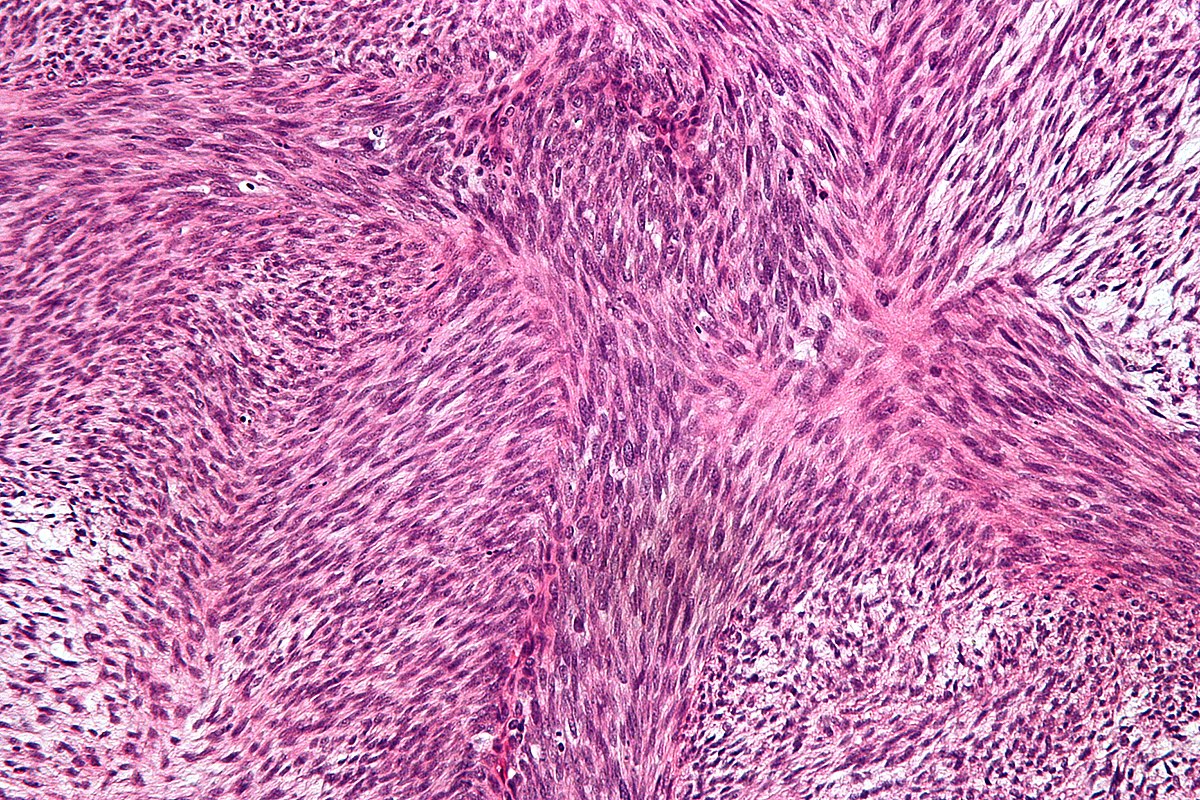Definition:
Malignant peripheral nerve sheath tumor arising from a peripheral nerve, neurofibroma or in a patient with neurofibromatosis type 1 (NF1).
If none of these criteria apply, then the diagnosis is relied on a combination of histology and immunophenotyping that reveal a differentiation from Schwann cells.
General:
Rare tumor (5% of soft tissue tumors)
50% associated with NF1, while 50% arise de novo.
Patients are from 20-50 years, but may arise in children with NF1.
Highly malignant and very aggressive
The sciatic nerve is the most commonly involved nerve.
Radiology:
No distinct radiological sign, besides from that the tumor has its origo in a peripheral nerve.
Macroscopic description:
Gross, spindled mass that involves a big nerve. Often bigger than 5 cm, and the cut surface is whitish with bleedings and necrosis.
Histologic description:
Spindle cells growing in fasciculations and ‘back-to-back’.
Mixture of cellularly dense and less dense areas
Geographic necrosis common
Cells have hyperchromatic nuclei and pale cytoplasm.
May have bizarre cells
Frequent mitotic figures (>4 mitoses/ 10 HPF)
Histologic images:
Positive stains:
S-100 (<50%), GFAP (20-30%)
Negative stains:
SMA, Desmin
Molecular analysis and cytogenetics:
Usually not used in diagnostics, but MPNST is overrepresented in NF1 patients.
Differential diagnosis:
Fibrosarcoma, monophasic synovial sarcoma, leiomyosarcoma, desmoplastic melanoma, neurofibroma with atypical features
Treatment and prognosis:
Radical surgery, often follow by radiation therapy.
Poor prognosis (5 year survival rate of about 35%)
Negative predictors: Localisation on truncus, tumor size > 5 cm, high grade tumor and radiation indused tumors.
Recurrence risk 40-65%
Metastasize to lung, bone, pleura, soft tissue, liver and brain
Almost everyone with metastatic disease dies
References:
WHO Classification of Tumours of Soft Tissue and Bone (IARC WHO Classification of Tumours), 4th Edition, 2013, edited by Christopher D. M. Fletcher, Julia A. Bridge, Pancras C. W. Hogendoorn and Fredrik Mertens
Enzinger & Weiss’s Soft Tissue Tumours, 6th Edition, edited by John R. Goldblum, Andrew L. Folpe and Sharon W. Weiss
Content by @janusface

Really useful info of medicine, Great work
Downvoting a post can decrease pending rewards and make it less visible. Common reasons:
Submit
Really i appreciate you. Good Post :)
Downvoting a post can decrease pending rewards and make it less visible. Common reasons:
Submit
Wonderful 💕
Downvoting a post can decrease pending rewards and make it less visible. Common reasons:
Submit
WOW
Downvoting a post can decrease pending rewards and make it less visible. Common reasons:
Submit
Thanks for sharing about it in details and in a simplified manner
Downvoting a post can decrease pending rewards and make it less visible. Common reasons:
Submit
disease,treatment and prevent is so important for to be cured...
good topic and well writing ..
prediction of Risk is also indicating your wisdom,sir...
like your post
@upvoted @resteem
Downvoting a post can decrease pending rewards and make it less visible. Common reasons:
Submit
That's a weird post from you, I hope all is ok my friend!
Downvoting a post can decrease pending rewards and make it less visible. Common reasons:
Submit
very good post :) your post have alot of information that i need to know thank you so much for sharing with us :) @ janusface
Downvoting a post can decrease pending rewards and make it less visible. Common reasons:
Submit
Downvoting a post can decrease pending rewards and make it less visible. Common reasons:
Submit